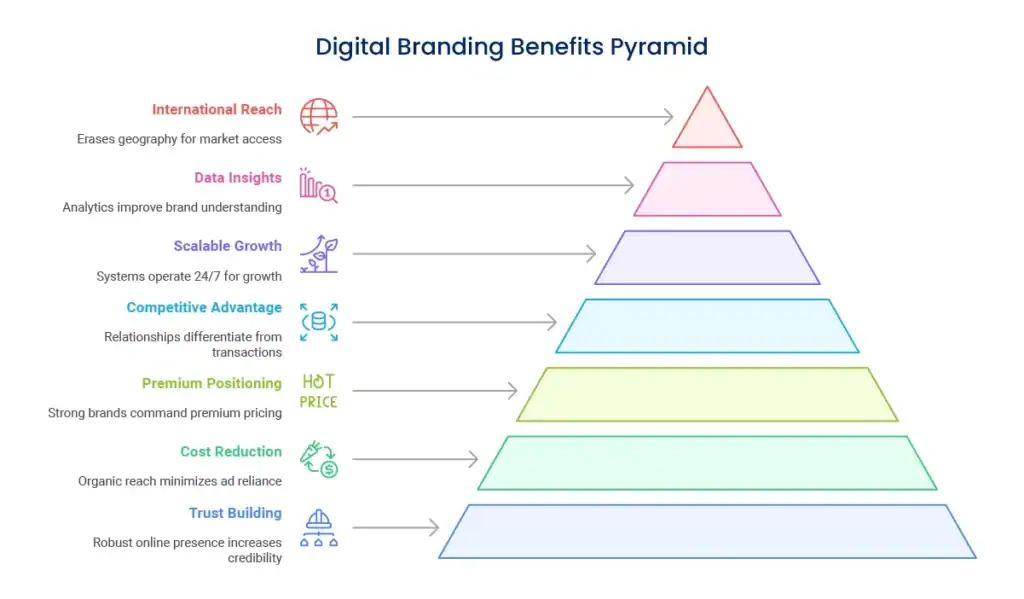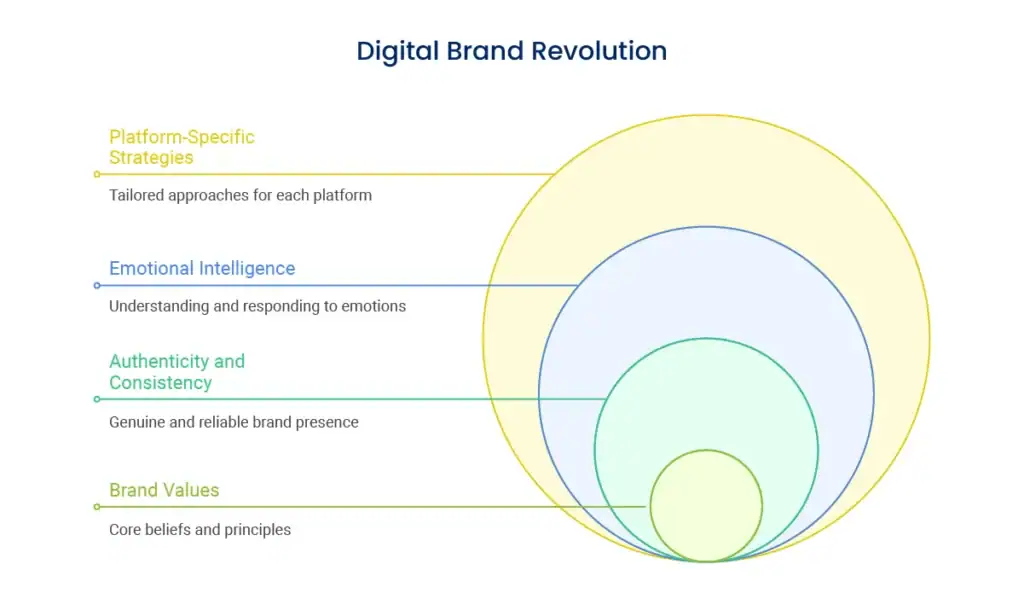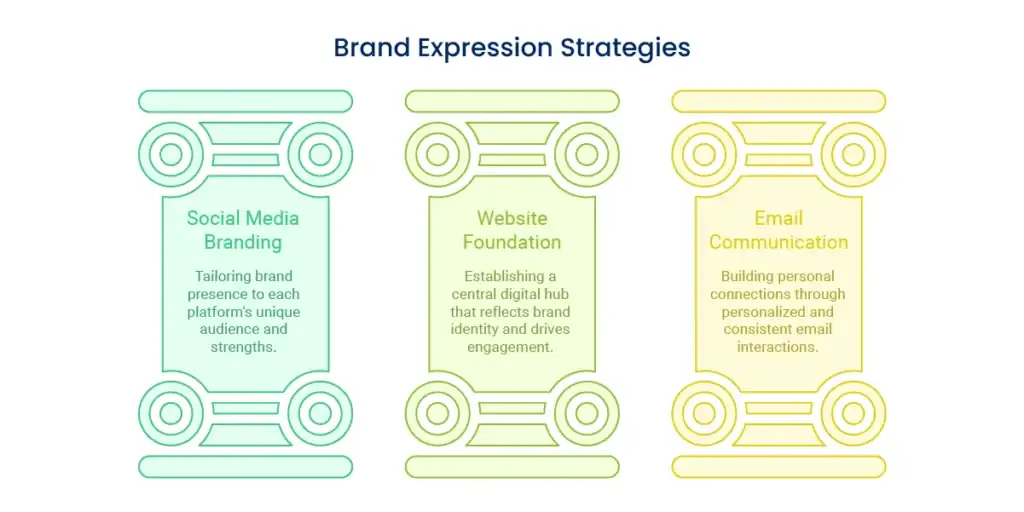Custom Design
Digital Branding Mastery: A Strategic Approach to Building a Magnetic Brand People Choose and Recommend
Is your brand lost in the digital din? You’re not alone. Most business owners watch their competitors going strong online while their own digital branding efforts result in shouting into a void.
Branding digitally is no longer merely having a website and logo. It’s about developing an attractive presence that draws visitors in, instills confidence, and converts casual browsers into passionate advocates who proactively refer others to your business.
This site will demonstrate to you step by step how to develop a strategic digital brand presence that not only lives on the web but flourishes there. We’ll take you through the building blocks, provide useful frameworks, and present you with actionable steps to develop a brand that people actually want to interact with and share.

Table of Content
What is Digital Branding?

Digital branding is the strategic process of creating and maintaining your brand’s identity, personality, and reputation on all digital channels and points of interaction. While traditional branding was focused on print and broadcast media, digital branding occurs where your customers actually engage – on social media, search engines, websites, and mobile apps.
Conceptualize digital branding as your brand’s entire digital persona. It includes everything from your visual identity and messaging to how you engage with customers online and the experiences you craft across digital channels.
Your internet brand identity encompasses your website layout, social media presence, writing style, customer service philosophy, and even the promptness with which you reply to comments. Each online interaction influences what people think about your brand, so consistency and planning are absolutely crucial.
The true strength of digital branding comes from its capacity to make real connections at scale. Done properly, it helps in building communities of customers who don’t merely purchase from you – they become your best marketing vehicle through word of mouth and social proof.
Why It Matters for Your Brand or Business
Digital branding reflects directly on your bottom line and long-term growth potential. Here’s why becoming proficient at it should be at the top of your list:

Building Trust
Consumers search for brands online prior to making a purchase. Having a robust digital presence increases credibility and minimizes hesitation to buy.
Reducing Customer Acquisition Cost
Proper digital brand strategy generates organic reach and referrals, minimizing your reliance on paid ads.
Premium Positioning
Strong digital brands can command premium pricing because customers feel more value.
Competitive Advantage
While your competition is about transactions, magnetic digital brands are about relationships and sustainable differentiation.
Scalable Growth
Digital branding establishes systems that operate 24/7, enabling you to grow without proportionally increasing marketing investment.
Data-Rich Insights
Digital platforms offer rich analytics on customer likes, allowing ongoing improvement of the brand.
The companies winning online aren’t always the ones with the largest budgets – they are the ones with the most strategic and persistent digital branding strategy.
The Digital Brand Revolution: Understanding the New Landscape

The Transition from Broadcasting to Conversation
The digital brand revolution has radically redefined the way brands interact. We've transitioned from broadcasting to conversations in which customers demand true engagement rather than promotional content.
Social media branding
Now demands brands to be useful, enjoyable, or inspiring. Customers can fact-check instantly, compare, and share with thousands of individuals. This openness has set new standards of authenticity and consistency.
The Emergence of Personal Branding Expectations
Today, consumers want personalities, values, and opinions from brands. They would like to connect with brands that hold similar beliefs and show genuine concern for issues other than money. This change demands that corporate branding strategy accommodate emotional intelligence as well as cultural sensitivity.
Platform-Specific Brand Expression Requirements
Every digital platform carries its own culture, algorithm, and user expectations. Your brand must extend its expression yet preserve core identity across platforms. What is effective on LinkedIn will not necessarily work on TikTok, but your brand values should be consistent.
Strategic Foundation: Building Your Digital Brand Architecture

Brand Core Definition
Your digital brand architecture begins with crystal-clear brand foundations. Establish your brand purpose, values, personality, and unique positioning before developing any digital assets. This foundation informs every digital decision and ensures touchpoint consistency.
Write down your brand voice, visual guidelines, and key messages in a detailed brand strategy development framework. This is your north star for all digital branding activity.
Audience Personas and Digital Behaviour Mapping
Knowing your audience’s online behavior is vital for successful digital branding. Plot where your target customers spend their time on the web, what they view, how they decide, and how they make purchases.
Develop in-depth personas that not only consist of demographics but also digital interests, platform habits, content viewing behavior, and online issues. This data informs your overall digital branding strategy.
Competitive Digital Landscape Analysis
Analyze the positioning of competitors online, what they do well, and where there are opportunities for gaps. Consider brands beyond direct competitors that your audience respects across other industries. Wider observation tends to uncover creative branding opportunities.
Get Real-Time Updates – Join Our Smart Health Platform
Creating Magnetic Brand Experiences
Emotional Connection Design
Magnetic brands establish emotional connections that transcend rational value. Design experiences that make individuals feel understood, valued, and part of something greater. This emotional layer turns customers into evangelists.
Utilize storytelling, user-generated content, and community building to form these deeper connections. Post behind-the-scenes content, honor customer successes, and regularly show your brand values in action, not just through words.
Consistency Across Touchpoints
Each digital touchpoint must somehow feel unmistakably yours. From the loading speed of your website to the tone of your social media response, consistency creates trust and recognition. Develop templates, guidelines, and processes that make your brand consistent no matter who is in charge of your digital presence.
This consistency applies to visual elements, tone of messaging, customer service style, and even the sorts of content you publish. Individuals should recognize your brand immediately in any platform or interaction.
Value-First Content Strategy
Magnetic brands put value ahead of promotion. Create content that actually helps, entertains, or inspires your audience before you ask for something in return. That builds goodwill and gets your brand recognized as a go-to resource.
Create a content marketing strategy that consistently serves up value for your audience around their interests and needs. Blend educational content, industry information, and fun content to maintain interest.
Stay Connected to Your Care – Join Our Patient Portal
Platform-Specific Brand Expression

Social Media Platform Optimisation
Every social platform demands customized brand expression with adherence to core identity. Visual storytelling is key in Instagram, professional opinions are preferred in LinkedIn, and creativity and authenticity are rewarded in TikTok.
Create platform-specific content strategies that take advantage of each platform’s strengths while remaining authentic to your brand voice. Your social media branding should appear natively on each platform but be recognizably yours.
Website as Brand Foundation
Your website is your digital branding headquarters where all other sites must drive traffic. Make sure that it has a great user experience that supports your brand positioning and encourages desired behavior.
Spend money on professional brand identity design that makes a lasting first impression and leads visitors to conversion. Your site should be fast, mobile-friendly, and in tune with your brand personality.
Email and Direct Communication Branding
Email marketing and direct communication provide avenues for greater personal expression of the brand. Leverage these to build deeper relationships with exclusive content, personalized recommendations, and behind-the-scenes access.
Be consistent in branding through email design, subject line tone, and frequency of communication. These direct communications need to feel like receiving a note from a good friend who just happens to have a business.
Community Building and Social Proof

Authentic Community Building
Creating a community behind your brand drives effective online reputation management and advocacy. Concentrate on unifying people through shared values or interests, not necessarily pushing your products.
Build venues where your audience interacts with one another, not necessarily with your brand. This fosters deeper loyalty and provides natural opportunities for word-of-mouth endorsements.
User-Generated Content Fostering
Engage and highlight content produced by your customers and community members. User-generated content offers real social proof while taking some of the content creation pressure off your shoulders.
Create processes to find, curate, and re-share user-generated content that resonates with your brand identity. Always tag creators and engage purposefully with their work to inspire even more participation.
Influencer and Partnership Strategy
Strategic collaborations with similar influencers and complementary brands can broaden your audience and credibility. Select partners whose audiences overlap with yours and share your brand values.
Prioritize cultivating authentic relationships instead of transactional transactions. Long-term collaborations with the right folks bring more value than individual promotional posts with more mass but less aligned audiences.
Data-Driven Brand Optimization
Brand Performance Metrics
Measure metrics that truly reflect brand strength, not vanity metrics. Aim for engagement quality, sentiment analysis, brand mention trends, and customer lifetime value in lieu of mere follower or like counts.
Monitor how your online branding work pays off in business terms. Measure metrics such as growth in organic traffic, referral rates, customer retention, and acceptance of premium pricing to measure actual brand influence.
Feedback Integration Systems
Develop systematic mechanisms to gather and include customer feedback in your brand plan. Ongoing surveys, social listening, and direct feedback avenues offer input for brand development.
Listen to how customers speak about your brand in their own terminology. Natural language usually surfaces brand perception gaps and opportunities for more alignment.
Crisis Management and Brand Resilience

Feedback Integration Systems
There should be ongoing monitoring and swift response ability in online reputation management. Establish monitoring mechanisms to monitor brand mentions, sentiment shifts, and possible problems before they become major issues.
Establish definite procedures for various kinds of reputation problems. Having response frameworks in place enables fast, proper reaction when there are problems.
Transparent Communication Strategies
When problems occur, transparent and honest communication often strengthens rather than weakens brand perception. Acknowledge mistakes, share what you’re doing to fix them, and follow through on promises.
Build trust through consistent transparency in good times and bad. Brands that communicate openly during challenges often emerge stronger than before.
Recovery and Learning Integration
Use reputation issues as moments to show your brand values and customer commitment. The way you manage troubles tends to be a stronger brand narrative than never encountering troubles.
Write down lessons learned from every difficulty and incorporate them into better processes and communication plans. This method transforms failures into brand fortifying opportunities.
Long-term Digital Brand Equity Building
Brand Evolution Planning
Plan for brand evolution while keeping core identity intact. Markets shift, audiences change, and new platforms arise. Incorporate flexibility into your brand structure to evolve without sacrificing recognition.
Periodically review and update brand expression while ensuring core elements remain constant. This ensures relevance without alienating loyal customers.
Legacy Content and Brand Assets
Develop content and brand assets that yield long-term value and not just short-term engagement. Learning materials, industry information, and informative guides continue to draw in and engage customers months and even years after production.
Establish a library of brand assets that can be repurposed and refreshed over time. This strategy maximizes content investment while sustaining continuous brand presence.
Sustainable Growth Strategies
Emphasize developing brand systems that can scale without compromising quality or authenticity. Document procedures, train staff, and develop guidelines ensuring brand consistency as you scale.
Spend on brand positioning strategies that segment you from others and erect barriers to entry for new entrants in your marketplace.
Long-term Digital Brand Equity Building
Brand Evolution Planning
Plan for brand evolution while keeping core identity intact. Markets shift, audiences change, and new platforms arise. Incorporate flexibility into your brand structure to evolve without sacrificing recognition.
Periodically review and update brand expression while ensuring core elements remain constant. This ensures relevance without alienating loyal customers.
Legacy Content and Brand Assets
Develop content and brand assets that yield long-term value and not just short-term engagement. Learning materials, industry information, and informative guides continue to draw in and engage customers months and even years after production.
Establish a library of brand assets that can be repurposed and refreshed over time. This strategy maximizes content investment while sustaining continuous brand presence.
Legacy Content and Brand Assets
Develop content and brand assets that yield long-term value and not just short-term engagement. Learning materials, industry information, and informative guides continue to draw in and engage customers months and even years after production.
Establish a library of brand assets that can be repurposed and refreshed over time. This strategy maximizes content investment while sustaining continuous brand presence.
Sustainable Growth Strategies
Emphasize developing brand systems that can scale without compromising quality or authenticity. Document procedures, train staff, and develop guidelines ensuring brand consistency as you scale.
Spend on brand positioning strategies that segment you from others and erect barriers to entry for new entrants in your marketplace.
Step-by-Step Guide to Digital Branding Mastery
1. Audit Your Current Digital Brand Presence
Begin by performing an in-depth audit of your current digital presence. Examine your website, social media accounts, online reviews, and search engine results. Take note of inconsistencies, opportunities, and gaps in the competition.
Utilize metrics such as Google Alerts, social media metrics, and customer comment analysis to assess existing brand perception. This baseline helps direct your improvement strategy.
2. Define Your Digital Brand Strategy
Create an explicit strategy that connects digital branding activities with business objectives. Identify your ideal customer base, essential messaging, visual identity, and platform prioritization based on where your desired customers are spending time.
Establish written guidelines for brand voice, visual, and content themes. This groundwork provides consistency across all digital touchpoints and team members.
3. Optimise Your Digital Foundation
Make sure your site is a great user experience that captures your brand personality. Optimize loading speed, mobile responsiveness, and navigation clarity while upholding robust visual branding.
All social media accounts should be updated with consistent branding elements, descriptive copy, and strategic keyword placement. Your profiles should explicitly define what you do and why it’s important.
4. Create Value-Driven Content Systems
Develop content processes that reliably provide value to your audience. Organize content topics, publication schedules, and distribution plans on selected platforms.
Keep the focus on answering questions, solving problems, and offering insights of relevance to your audience’s interests and issues. Doing this brings trust and makes your brand a valuable resource.
5. Construct Community Engagement Processes
Establish systematic methods of interacting with your community across digital channels. Quickly respond to comments, post user-generated content, and join the conversation where relevant.
Build ways for people in your community to interact with each other via your brand. This engenders better relationships and boosts customer lifetime value.
6. Use Monitoring and Measurement
Establish in-depth monitoring systems to monitor brand mentions, sentiment, and performance metrics. Employ solutions that offer insights into how the brand is perceived and digital presence effectiveness.
Regularly examine performance data to determine trends, opportunities, and room for improvement. Utilize these findings to optimize your strategy and maximize results.
7. Scale and Systematise Success
Document successful strategies and implement systems for scaling successful approaches. Educate team members in brand guidelines and implement approval processes for quality maintenance.
Constantly experiment with new platforms, content types, and engagement techniques to be ahead of market shifts and audience interests.
8. Plan for Long-term Evolution
Design flexibility into your digital branding strategy in order to change and evolve with shifting markets, technologies, and audience interests while sustaining core brand identity.
Periodically review and revise your online brand strategy from the performance metrics, market developments, and business expansion needs.
Recommended Tools and Methods
Brand Management Platforms
Canva Pro (₹3,000 per year) offers professional design templates and brand kit features to ensure visual consistency across digital spaces. It is best for teams that require creating branded content without having design skills.
Buffer (₹4,500 per month) provides end-to-end social media management with brand consistency tools. It supports scheduling, analysis, and team collaboration while preserving brand voice on different platforms.
Analytics and Monitoring Tools
Google Analytics 4 (free) offers in-depth website performance, audience behavior, and content effectiveness insights. Implement conversion tracking to track how online branding activities contribute to business outcomes.
Hootsuite Insights (₹15,000 per month) includes advanced social listening and sentiment analysis features. Track brand mentions, follow competitor activity, and detect trending conversations of interest to your audience.
Content Creation Systems
Notion (₹8,000 yearly per user) is a great content planning and brand guideline management tool. Make detailed brand documentation, content calendars, and collaboration workflows.
Loom (₹6,000 yearly) makes genuine brand communication possible through personalized video content. Utilize it for customer support, product demos, and behind-the-scenes brand storytelling.
Common Mistakes and Pitfalls
Inconsistent Brand Expression
One of the most hurtful errors in online branding is having inconsistent expressions on different platforms. When your Instagram is totally different from your LinkedIn or website, it annoys people and dissipates brand recognition.
Keep fundamental brand attributes such as voice, values, and visual style consistent while varying content form to fit platform needs. Your brand should be identifiable wherever it shows up.
Focus on Vanity Metrics
Numerous brands become bogged down in likes and followers instead of tracking real business effects. High engagement is not worth anything if it doesn’t turn into customer acquisition, retention, or higher lifetime value.
Prioritize metrics that report real brand health: referral rates, growth in organic traffic, customer retention, and the power to charge premium prices.
Over-Promotion and Under-Serving
Numerous brands become bogged down in likes and followers instead of tracking real business effects. High engagement is not worth anything if it doesn’t turn into customer acquisition, retention, or higher lifetime value.
Prioritize metrics that report real brand health: referral rates, growth in organic traffic, customer retention, and the power to charge premium prices.
Ignoring Platform-Specific Best Practices
Every digital platform contains its own culture, algorithms, and user expectations. Brands that employ the same content on all platforms fail to take advantage of enhanced engagement and algorithmic favorability.
Adjust your content approach per platform while ensuring brand consistency. Your LinkedIn approach may not work for TikTok, but your values must be consistent.
Frequently Asked Questions
How Long Does it Take to Create a Powerful Digital Brand?
Creating an established digital brand can take 6-12 months of sustained effort, depending on your sector, audience, and level of resource investment. However, early gains in brand perception can occur as soon as 4-6 weeks after making strategic changes.
The most important thing is consistency and patience. Digital branding is closer to fitness than to surgery – more consistent day-to-day effort yields more effective long-term outcomes than hard work on a short-term basis.
What's the Optimal Budget for Digital Branding?
Small to medium-sized businesses need to budget 10-15% of revenue for digital branding activities, such as content creation, advertising, tools, and professional services. Startups may spend a larger percentage up front to create market presence.
Prioritize the budget for the most return-critical areas for your particular audience. At times, organic content generation is more effective than paid advertising, but other companies are helped most by strategic partnerships or influencer relationships.
Can Digital Branding Work for B2B Companies?
Small to medium-sized businesses need to budget 10-15% of revenue for digital branding activities, such as content creation, advertising, tools, and professional services. Startups may spend a larger percentage up front to create market presence.
Prioritize the budget for the most return-critical areas for your particular audience. At times, organic content generation is more effective than paid advertising, but other companies are helped most by strategic partnerships or influencer relationships.
Final Thoughts
Mastering digital branding isn’t about executing on every platform or staying on top of every trend. It’s about building genuine relationships with your target audience where they already naturally congregate online.
The companies that are winning online aren’t always the loudest or best-funded. They’re the ones who are showing up again and again with valuable content, real personality, and ongoing dedication to serving their audience.
Your online brand has to be the best possible version of your business personality – genuine, useful, and memorable. When you get this combination right, you build an attracting presence that draws in customers, forms loyalty, and creates the type of word-of-mouth promotion that cannot be purchased.
Begin with engaging foundations, remain consistent in your efforts, and know that online branding is a long-term investment for long-term business growth. The effort you exert in establishing genuine relationships and quality content today becomes your competitive edge that fuels growth for the long haul.
Need Help with Your Digital Branding Strategy?
Building a magnetic digital brand takes strategic vision, relentless execution, and sometimes outside perspectives from seasoned professionals. If you’re ready to create a digital presence that truly draws in and keeps customers, our group excels at crafting integrated brand communication strategies that drive quantifiable outcomes.
We collaborate with visionary business owners who realize that solid online branding is crucial for long-term growth and market competitiveness in today’s markets.
